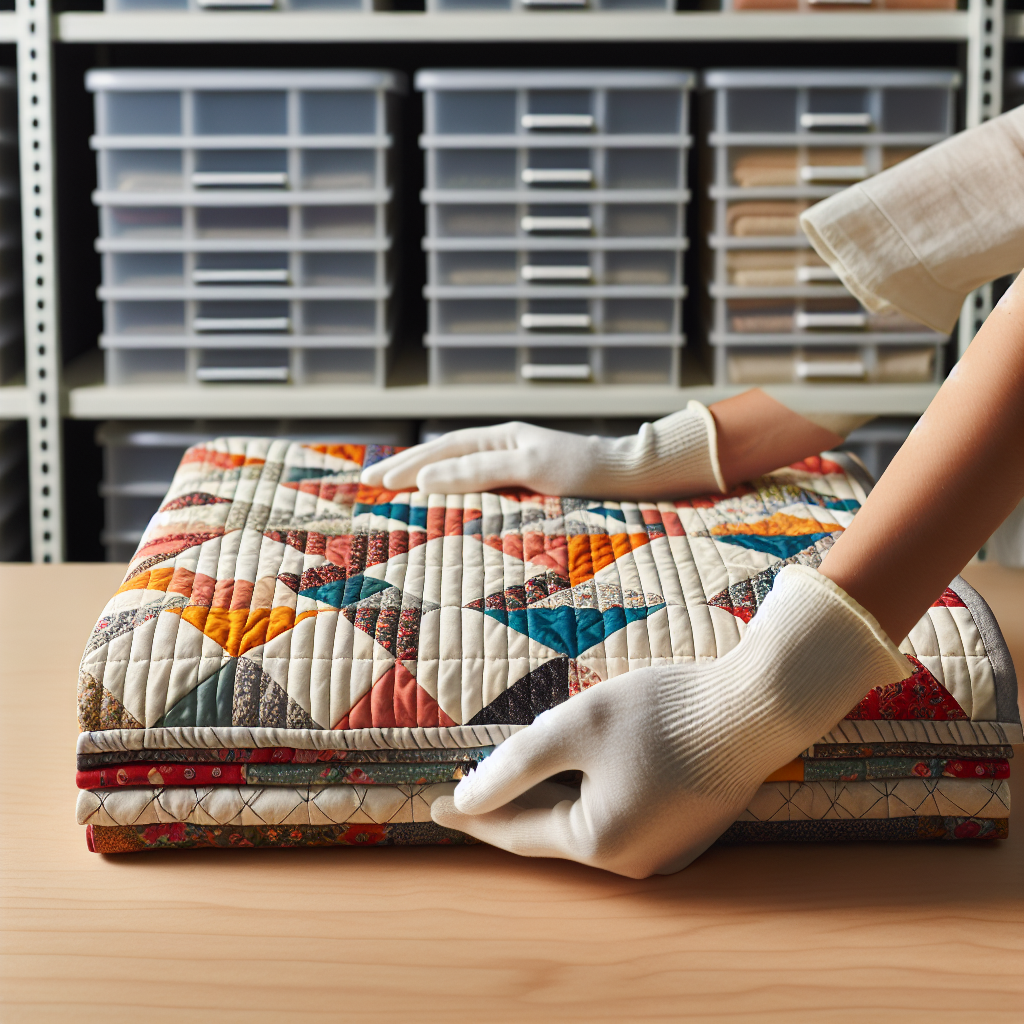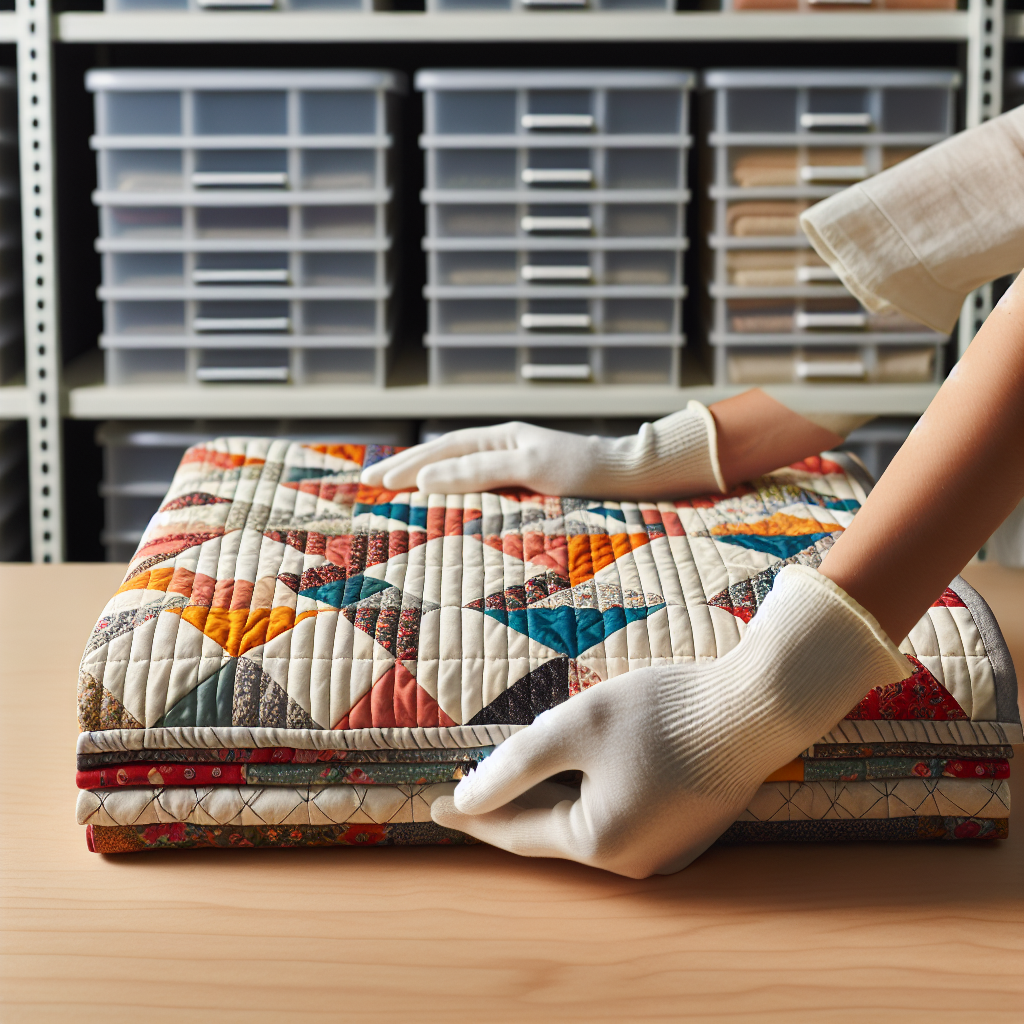Maintaining and cleaning your quilts is essential for ensuring their longevity. This article provides useful tips and techniques to help you preserve the beauty and quality of your beloved quilts. From regular gentle washing to proper storage, these practices will not only extend the lifespan of your quilts but also keep them looking fresh and vibrant for years to come. So, let’s dive in and discover how you can take care of your quilts in the best possible way!
Regular Cleaning
Consider the Fabric
When it comes to regular cleaning of your quilts, one important factor to keep in mind is the fabric. Different fabrics require different cleaning methods. Take the time to check the care instructions on the label or consult the manufacturer’s guidelines. This will ensure that you choose the appropriate cleaning routine and avoid any potential damage or shrinkage.
Check for Colorfastness
Before you begin the cleaning process, it’s crucial to check for colorfastness. This means ensuring that the colors on your quilt won’t bleed or fade during cleaning. To do this, dampen a white cloth or cotton swab with water and gently rub it on a small, inconspicuous area of the quilt. If any color transfers onto the cloth, it’s an indication that the quilt may not be colorfast. In such cases, it’s best to seek professional cleaning assistance.
Pre-treat Stains
Stains can be a pesky problem that can ruin the beauty of your quilt. To prevent permanent staining, it’s important to pre-treat any stains before washing. Depending on the type of stain, you may need different methods of treatment. For food or beverage stains, blot the area with a damp cloth and mild detergent. For oil-based stains, apply talcum powder or cornstarch to absorb the oil before brushing it off. Always remember to test any cleaning agents on a small, inconspicuous area first to ensure they won’t damage the fabric.
Use Gentle Detergent
When it comes to washing your quilts, it’s essential to use a gentle detergent. Harsh detergents can strip the fabric of its natural oils and lead to discoloration or damage. Look for a detergent specifically designed for delicate fabrics or one that is labeled as “gentle” or “mild.” Avoid using bleach or fabric softeners, as they can cause further damage. Opt for a cold or lukewarm water temperature and a gentle cycle on your washing machine. Remember to never overcrowd the machine to allow the quilt to move freely.
Proper Storage
Clean Before Storage
Before you think about storing your quilts, it’s crucial to ensure they are clean. Any dirt or stains left on the quilt can attract pests or cause further damage during storage. Follow the regular cleaning tips mentioned above before putting your quilts away for an extended period. Take care to address any stains promptly and ensure the quilt is thoroughly dry before storage.
Avoid Sunlight Exposure
Sunlight is one of the major factors that can lead to fading and deterioration of quilts over time. When storing your quilts, choose a location away from direct sunlight. Sunlight can bleach the colors and cause the fabric to become brittle. If you’re displaying your quilt, consider using UV-protective glass or window films to help minimize the harmful effects of sunlight.
Use Acid-Free Tissue Paper
When it comes to proper quilt storage, using acid-free tissue paper is highly recommended. This helps to protect the fabric and prevent any yellowing or discoloration. Before folding the quilt, place a layer of acid-free tissue paper between each fold. This will help to cushion and protect the fabric from any potential friction or creases.
Avoid Plastic Bags
While it may be tempting to store your quilts in plastic bags for protection, it’s best to avoid this method. Plastic bags can trap moisture, leading to mold and mildew growth. Additionally, plastic can create an environment that doesn’t allow for proper airflow, which is crucial for maintaining the freshness and longevity of your quilts. Instead, opt for breathable fabric storage bags or cotton covers that allow for ventilation.

Avoid Excessive Wear and Tear
Rotate Quilts
To avoid excessive wear and tear in specific areas of your quilts, it’s a good idea to rotate them periodically. By exchanging quilts or changing their positions every few months, you distribute the pressure and prevent any one area from bearing the brunt of wear. This is especially important for quilts used on beds or frequently displayed in high-traffic areas.
Minimize Direct Contact with Skin
While quilt cuddling is undeniably cozy, excessive direct contact with skin can lead to faster wear and tear. Natural oils, lotions, and even perspiration can transfer from our bodies onto the fabric, causing staining, discoloration, and weakening of the threads over time. To minimize this, consider using a thin cotton or muslin cover between your skin and the quilt.
Keep Pets Away
As much as we love our furry friends, it’s important to keep them away from your quilts. Pet hair, dander, and claws can cause irreversible damage to the delicate fabric. Encourage your furry companions to enjoy other cozy spots and provide them with their own designated blankets to snuggle on.
Handle Carefully
When handling your quilts, it’s crucial to do so with care. Avoid pulling or tugging on the fabric, as this can result in tears or loosening of the stitches. Always support the weight of the quilt with both hands when lifting or folding. It’s also a good idea to remove any jewelry or accessories that could snag or catch on the fabric.
Preventing Mold and Mildew
Maintain Optimal Humidity Levels
To prevent the growth of mold and mildew on your quilts, it’s crucial to maintain optimal humidity levels. The ideal humidity range for quilt storage is between 40% to 50%. Use a hygrometer to monitor the humidity in the storage area and invest in a dehumidifier if necessary. High humidity levels can create a damp environment, while extremely low humidity can cause the fabric to become brittle.
Store in Dry Environment
In addition to controlling humidity, it’s essential to store your quilts in a dry environment. Basements and attics are often prone to moisture and temperature fluctuations, which can be detrimental to the fabric. Consider storing your quilts in a climate-controlled area of your home, such as a closet or spare bedroom.
Air Out Quilts Regularly
Even when stored in ideal conditions, it’s beneficial to air out your quilts periodically. This allows for proper ventilation and prevents any stagnant air from promoting mold or mildew growth. Lay the quilt flat on a clean and dry surface, preferably in a shaded area, and leave it to air out for a few hours.
Use Moisture Absorbers
To further safeguard your quilts from mold and mildew, consider using moisture absorbers in the storage area. Silica gel packs or activated charcoal can help to absorb any excess moisture and maintain a dry environment. Just remember to keep these products away from direct contact with the quilts, as they can leave behind residue or stains.

Repairing and Restoring
Repair Tears or Loose Threads
Over time, quilts may experience tears or loose threads, especially in high-use areas. It’s important to address these issues promptly to prevent further damage. Sewing up small tears or using a small amount of fabric glue can help to secure loose threads and prevent them from unraveling. For larger tears or extensive damage, it’s best to seek the assistance of a professional quilt restorer.
Reinforce Quilt Edges
The edges of your quilts are often more susceptible to fraying and damage. To reinforce and protect these areas, consider adding binding or a fabric border around the edges. This will provide extra support and prevent the fabric from unraveling or deteriorating.
Patch or Replace Damaged Sections
If your quilt has significant damage to a specific section, such as a large stain or tear, you may consider patching or replacing that area. Patching involves carefully matching fabric and stitching it onto the damaged section. If the damage is beyond repair, you might need to replace the affected portion entirely. Seek professional assistance if you’re unsure of how to proceed.
Avoid Harsh Cleaning Methods
Avoid Bleach and Harsh Chemicals
When it comes to cleaning your quilts, it’s essential to avoid bleach and harsh chemicals. These can cause discoloration, weaken the fabric, and potentially damage any delicate stitching. Stick to gentle detergents specifically formulated for delicate fabrics and follow the manufacturer’s instructions for the best results.
Skip Dry Cleaning
While dry cleaning may seem like a convenient option, it’s generally best to avoid it for quilts. Dry cleaning chemicals can be harsh and may not be suitable for all types of fabrics used in quilts. Furthermore, the agitation and heat involved in the process can cause damage. It’s always advisable to follow the care instructions provided by the quilt manufacturer or consult a professional cleaner if you’re unsure.
Avoid High Heat
Excessive heat is another factor to avoid when cleaning quilts. High temperatures can cause shrinkage, color fading, or even damage the fabric. Always opt for cold or lukewarm water temperatures when washing your quilts and avoid using high heat settings when drying. Air drying quilts flat or hanging them on a clothesline is the gentlest method for drying.
Be Gentle during Washing
Lastly, it’s crucial to handle your quilts with care during the washing process. Avoid vigorous scrubbing, wringing, or rubbing the fabric together, as this can damage the delicate stitching and fabric. Instead, gently swish the quilt in the water and allow it to soak for a short period. Treat the quilt as a fragile piece of artwork and handle it accordingly.
Professional Cleaning Services
Choose a Trustworthy Cleaner
If your quilt requires professional cleaning, it’s essential to choose a trustworthy and experienced cleaner. Seek recommendations from fellow quilters or do thorough research to find a cleaner specializing in quilt care. Look for certifications or accreditations that demonstrate their expertise and commitment to preserving the fabric’s integrity.
Communicate Quilt Details
When entrusting a professional cleaner with your quilt, it’s crucial to communicate any important details. This includes information about the fabric type, any existing stains or damage, and any specific concerns you may have. A clear and open line of communication ensures that the cleaner understands your expectations and can tailor their cleaning methods accordingly.
Discuss Cleaning Techniques
Before proceeding with professional cleaning, have a discussion with the cleaner about their proposed cleaning techniques. Ensure that they are aware of your desire for gentle cleaning methods and inquire about the products they plan to use. A reputable cleaner should be able to explain their cleaning process and provide reassurance that your quilt will be treated with the utmost care.
Ask for Proper Packaging
When receiving your quilt back from professional cleaning, it’s important to ask for proper packaging. Ideally, the quilt should be carefully folded and placed in acid-free tissue paper or a cotton storage bag to protect it during transport and storage. Avoid plastic packaging, as it can trap moisture and limit airflow.
Caring for Antique Quilts
Consult a Professional
Antique quilts require special care to preserve their historical and sentimental value. If you own an antique quilt or believe you have one in your possession, it’s crucial to consult a professional quilt appraiser or conservator. These experts can provide valuable insights and guidance on the best practices for caring for your antique quilt.
Avoid Washing if Possible
When it comes to cleaning antique quilts, the general rule of thumb is to avoid washing them if possible. The fragility and age of the fabric often make it too risky to subject them to water and detergent. Instead, focus on gentle spot cleaning and regular airing to remove any dirt or odors.
Consider Gentle Spot Cleaning
If your antique quilt requires cleaning due to minor stains or dirt, consider gentle spot cleaning. Use a clean, white cloth dampened with a mild detergent diluted in water to gently dab and blot the stained area. Avoid rubbing or excessive agitation, as this can damage the delicate fabric. Always test any cleaning agents on a small, inconspicuous area first to ensure they won’t cause discoloration or harm.
Use Museum-Quality Storage
When it comes to storing antique quilts, it’s crucial to invest in museum-quality storage materials. Acid-free tissue paper, unbleached cotton sheets, and archival boxes or acid-free containers are recommended. These materials are specifically designed to protect delicate fabrics and prevent any damage or deterioration caused by acids or chemicals found in regular storage materials.
Revitalizing Quilts
Gently Steam or Press
Over time, quilts may become wrinkled or lose their shape. To revitalize them, it’s possible to gently steam or press the quilt. Steam can help relax the fabric and smooth out any wrinkles. Be cautious not to place the iron or steamer directly on the quilt, as this can cause damage. Instead, hold the iron or steamer a few inches above the quilt and allow the steam to penetrate the fabric.
Avoid Heavy Ironing
While steaming or pressing can help freshen up your quilts, heavy ironing should be avoided. High heat and excessive pressure can flatten the loft or batting and damage the delicate stitching. If the quilt requires additional smoothing, use a low heat setting on the iron or sandwich it between two cotton fabrics before applying gentle pressure.
Fluff and Beat the Quilt
To restore the cozy and fluffy feeling of your quilt, give it an occasional fluff and beat. This helps to redistribute the fluffiness and remove any dust or debris that may have settled within the layers. Take the quilt outside and gently shake it, allowing fresh air to flow through the fabric. Lightly beat the quilt using a clean tennis racket or a designated quilt beater.
Consider Reapplying Batting
If your quilt has lost its original loft or batting thickness, it may be necessary to consider reapplying batting. Batting gives quilts their warmth, weight, and structure. Over time, batting can become thin or compacted, resulting in a less fluffy appearance. Consult a professional or follow a trusted tutorial to carefully remove the quilt’s stitching, replace the old batting, and re-stitch or tie the layers together.
Regular Inspection
Look for Signs of Damage
Regularly inspecting your quilts can help you catch any signs of damage early on. Look for loose threads, tears, or fraying along the seams or edges. Check for any discoloration, fading, or stains that may have developed. By identifying these issues promptly, you can address them before they worsen and potentially save your quilt from further damage.
Check for Insect Infestation
Insects, particularly moths and carpet beetles, can wreak havoc on quilts if left unchecked. These pests are attracted to natural fibers, such as cotton or wool, and can cause irreversible damage by feeding on the fabric. Inspect your quilts for any signs of insect infestation, such as holes or shed skins. If you suspect an infestation, take immediate action to prevent the pests from spreading further.
Address Issues Promptly
When you discover any issues during your inspection, it’s crucial to address them promptly. Small tears or loose threads can be repaired with minimal effort if caught early. Stains may require immediate attention to prevent them from setting permanently. The key is to intervene as soon as possible to minimize the potential damage and extend the lifespan of your quilt.
Consider Professional Restoration
If your quilt has significant damage or valuable historical significance, it may be worth considering professional restoration. Quilt restoration requires specialized knowledge and skills to preserve the quilt’s original integrity while repairing any damage. Consult with a reputable quilt restorer to assess the restoration needs and explore the best course of action for your quilt.
In conclusion, maintaining and cleaning your quilts regularly is essential for their longevity and continued enjoyment. By considering the fabric, pre-treating stains, using gentle detergents, and proper storage techniques, you can help preserve the beauty and quality of your quilts for years to come. Remember to avoid excessive wear and tear, prevent mold and mildew, repair and restore as needed, choose safe cleaning methods, and consider professional cleaning services when necessary. Additionally, caring for antique quilts requires special attention and consultation with experts, while revitalizing quilts involves gentle steaming or pressing, fluffing, and reapplying batting when needed. Regular inspection is crucial to address any signs of damage or insect infestation promptly. By following these tips and taking a proactive approach to quilt care, you can ensure that your beloved quilts remain in excellent condition and continue to bring warmth and beauty to your home.
